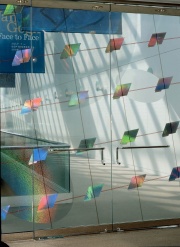Difference between revisions of "Laminated glass"
| (One intermediate revision by the same user not shown) | |||
| Line 2: | Line 2: | ||
== Description == | == Description == | ||
| − | Two sheets of glass with a thin layer of plastic adhered between. Laminated glass was invented in 1903 by Édouard Bénédictus in France after he accidentally knocked over a glass test tube containing a dried film of [[Cellulose nitrate]] and noticed that the glass fragments remain attached to the plastic rather than scattering. During World War I, laminated glass was used to strengthen the windshields of military vehicles as well as for the eyepieces in gas masks. After the war, [[safety glass]] was adapted for use in automobile windshields | + | Two sheets of glass with a thin layer of plastic adhered between. Laminated glass was invented in 1903 by Édouard Bénédictus in France after he accidentally knocked over a glass test tube containing a dried film of [[Cellulose nitrate]] and noticed that the glass fragments remain attached to the plastic rather than scattering. During World War I, laminated glass was used to strengthen the windshields of military vehicles as well as for the eyepieces in gas masks. After the war, [[safety glass]] was adapted for use in automobile windshields. When broken, the glass fragments remain attached to the plastic rather than scattering. The interlayer can be [[polycarbonate]], [[Ethylene vinyl acetate|ethylene-vinyl acetate]] (EVA), [[polyvinyl butyral]] (PVB), or thermoplastic [[Polyurethane]] (TPU). The polymer interlayer gives the glass a much higher sound insulation rating, due to the damping effect, and also blocks most of the incoming UV radiation (88-99.9%). |
For additional information, see: | For additional information, see: | ||
Latest revision as of 14:40, 11 November 2024
Description
Two sheets of glass with a thin layer of plastic adhered between. Laminated glass was invented in 1903 by Édouard Bénédictus in France after he accidentally knocked over a glass test tube containing a dried film of Cellulose nitrate and noticed that the glass fragments remain attached to the plastic rather than scattering. During World War I, laminated glass was used to strengthen the windshields of military vehicles as well as for the eyepieces in gas masks. After the war, Safety glass was adapted for use in automobile windshields. When broken, the glass fragments remain attached to the plastic rather than scattering. The interlayer can be Polycarbonate, ethylene-vinyl acetate (EVA), Polyvinyl butyral (PVB), or thermoplastic Polyurethane (TPU). The polymer interlayer gives the glass a much higher sound insulation rating, due to the damping effect, and also blocks most of the incoming UV radiation (88-99.9%).
For additional information, see:
- Exhibit Guidelines Technical Notes: Selecting Exhibit Glazing
- Exhibit Guidelines Technical Notes: Security Glazing for Exhibit
Synonyms and Related Terms
safety glass; verre laminé (Fr.); verre calandré (Fr.); gelaagd glas (Ned.); vidro laminado (Port.)
Applications
- Architecture, glazing, automobile windows
- UV protection, skylights
- Weather resistance (hurricanes, wind, etc.) in store fronts and windows.
- Sound reduction
Environmental Risks
- Laminated glass is not recyclable (as of 2024) Methods are being tried for the component separation.
- In Europe, laminated glass in no longer allowed in landfills
Working Properties
The plastic interlayer makes cutting the glass difficult. It is recommended that the glass be scored and broken then a heat lamp or hot air blower be used to melt the polymer along the break.
Minor damage can be visibly reduced by drilling a hole up to the lamination layer then injecting a clear UV-curable adhesive to fill the crack lines in the glass
Resources and Citations
- Wikipedia: Laminated glass Accessed Nov. 2024
